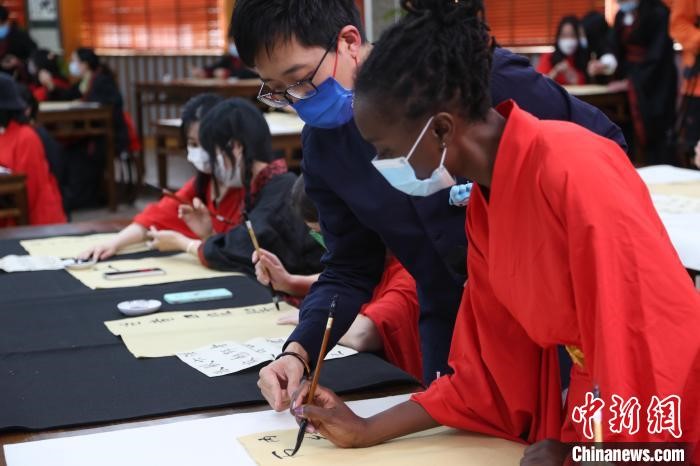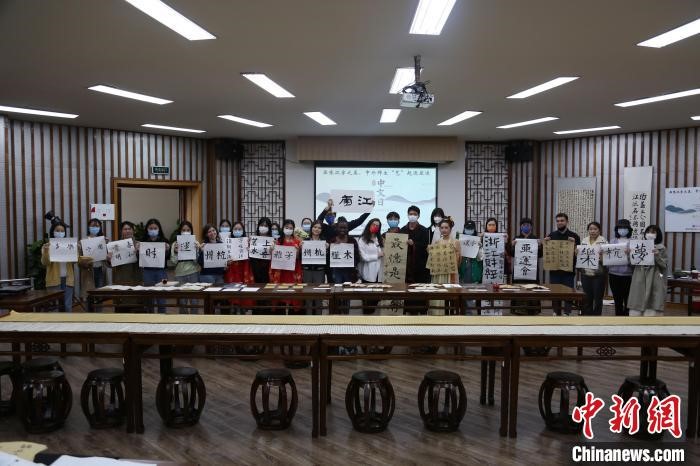
Foreign students practicing calligraphy; Photo courtesy of ZUFE
CHINANEWS (reported by Tong Xiaoyu, Zhao Lei, Gao Xin, Lv Luqi on April 20), "It's hard for my friends to imagine that I can pick up a Chinese brush and create a calligraphy work without knowing much about Chinese characters," Mu Jin, a Zambian student studying at ZUFE, said proudly.
April 20, 2022 represents the 13th United Nations Chinese Language Day. At the Wenjin Academy of ZUFE in Hangzhou, Zhejiang Province, more than 30 Chinese and foreign teachers as well as students dressed in Han Fu (Han-style clothing), carefully held the Chinese brushes and wrote with ink. Here they expressed their thoughts and expectations on Hangzhou and on the 19th Asian Games in Hangzhou in 2022 (hereinafter referred to as "Hangzhou Asian Games"), thus to warmly welcome it with works of art.
As the saying goes, "Once upon a time, when Cang Jie (the inventor of Chinese characters in legend) created characters, millet fell from the sky and ghosts cried at night." April 20 is the Grain Rain of the twenty-four solar terms, and it is also the day when Cang Jie created the Chinese characters. Learning Chinese is the most frequent event held on the Chinese Language Day.

Site of the Event; Photo courtesy of ZUFE
According to Su Hao, the speaker of this event and a teacher from the School of Humanities and Communication of ZUFE, the theme of this event is "taste the beauty of Chinese characters and welcome the Asian Games with works of arts created by both students and teachers at home and abroad." He hoped that teachers and students can appreciate the beauty of Chinese characters by speaking Chinese, reading Chinese books, wearing traditional Chinese clothes (Han Fu), and writing Chinese characters.
Walking into the Wenjin Academy, one can see the calligraphy vertical scrolls written with various fonts hanging on the wall. There are also 40 Chinese books displayed on the wooden table that is covered by a 14-meter-long calligraphy scroll.
Here, Su Hao introduced the engraved or lithographed books including Complete Library in the Four Branches of Literature, Commentary on Article Standard and Quotes From Art and Literary Circles.
When introducing the Zhu Shi (The History of Stag), Su Hao took advantage of the Hangzhou Asian Games to deepen the impression of the foreign students. He mentioned that the Zhu character has the component of Lu which in English means deer. What’s more, the deer is closely related to Liangzhu culture. "The Liangzhu culture is the inspiration for Cong Cong, the mascot of the Hangzhou Asian Games."
In addition to Chinese characters, clothing is also an important carrier of Chinese culture. At the event, foreign students put on their own Han Fu. Zhao You, 2021 Master of Humanities and Communication (Major of International Chinese Education), showed us some ancient etiquette in a chest Ru skirt in the style of the Tang Dynasty.
She said that for international students, Chinese cultural experience can bring more of a sense of participation, which is much more intuitive than traditional classroom teaching.
Writing Chinese characters is considered by many foreign students as "the most challenging" event. Su Hao said that the key words for international students to write were "West Lake," "Liangzhu," "Grand Canal," and "Asian Games".
"I think calligraphy is very interesting." Qian Duoduo, an international student from Russia, said that when learning calligraphy, he can see the beauty of Chinese characters and understand how broad and profound the Chinese culture is. "Although I’m not very good at calligraphy, I will practice more in the future and get better at it."
Su Hao said that after this event, ZUFE will continue to carry out activities including Chinese tea culture appreciation and tasting events, poetry gatherings, and so on. These events can not only encourage teachers and students to have a deep understanding of Chinese culture, but spread Chinese culture as well.
